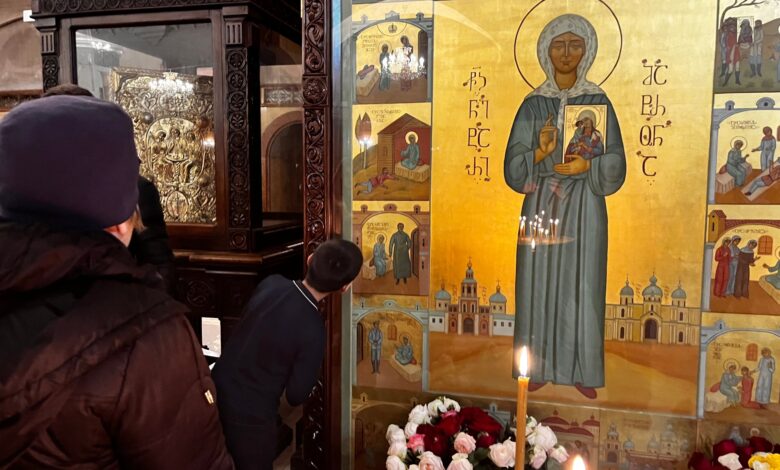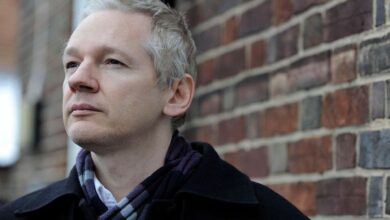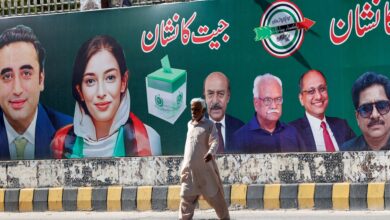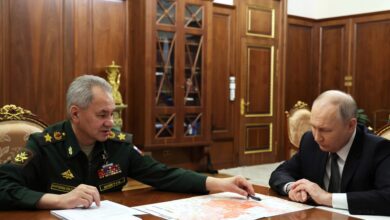Death threats for a Stalin vandal prompt soul-searching in Orthodox Georgia

Tbilisi, Georgia – When Nata Peradze heard that an icon featuring Joseph Stalin was on display inside Georgia’s largest cathedral, she decided to take action.
“It’s my pain,” Peradze told Al Jazeera. “We have no [discussions] about what happened and no memorials for the people who went through hell because of this guy. There were priests on my father’s side and on my mother’s there were dissidents. Some were deported to Siberia and some were lost and we never knew what happened to them.”
On January 9, the anticorruption activist and avowed atheist went inside Tbilisi’s Holy Trinity Cathedral to find the offending painting of the Georgian-born Soviet leader.
“I had my method. I had put paint inside three eggs and then waxed them closed. A priest was standing next to me, and I threw the eggs at the painting and he asked, ‘What are you doing?’ I said ‘It’s Stalin, he killed my ancestors!’”
![[Robin Forestier-Walker/Al Jazeera]](https://www.aljazeera.com/wp-content/uploads/2024/01/IMG_0879-1705490807.jpeg?w=770&resize=770%2C578)
Debates about her vandalism of the icon, named Holy Matrona of Moscow blesses Stalin, turned ugly on Facebook. Peradze received death threats.
Despite archives proving Stalin ordered the executions of thousands of innocent civilians during the Great Terror, including large numbers of clergy, Georgian society is divided over his legacy decades later.
Public discussions rage on social media as false narratives that Stalin was secretly a devout Orthodox Christian proliferate.
In one popular myth, Stalin ordered an aircraft during the second world war to circle Moscow mounted with a religious icon, saving the Soviet Union’s capital from German occupation. The same narratives argue Stalin did not know about the mass killings or that if he did know, they were necessary and that his kind of leadership is needed now.
This month’s scandal has threatened to spiral into a more dangerous phase of polarisation ahead of a highly anticipated general election later this year.
While Georgia’s government insists it represents a majority of Georgians who want NATO and European Union membership – it took credit for the EU’s decision to grant Georgia EU candidate status in December – its critics say it is quietly building ties with the Kremlin and spreading Russian disinformation.
‘Stalin’s personality is like a strategic axis’
Giorgi Kandelaki of Sovlab, a Soviet history research organisation which aims to counter what it describes as Russia’s weaponisation of the past, says the icon was a triumph of Moscow’s propaganda.
“Cultivation of [an] anti-Western, ethno-religious and chauvinistic strait of Georgian nationalism is [a] key long-term goal of Russia in Georgia and in that project Stalin’s personality is like a strategic axis, an umbrella.”
In step with the Kremlin’s rehabilitation of Stalin as a wise and honourable leader who is given all the credit for the defeat of Nazi Germany, there has been a resurgence in Stalin’s popularity in Georgia, with at least 11 new statues of him appearing since the governing Georgian Dream party came to power in 2012.
![[Robin Forestier-Walker/Al Jazeera]](https://www.aljazeera.com/wp-content/uploads/2024/01/IMG_0840-1705490675.jpeg?w=770&resize=770%2C578)
Meanwhile, far-right nationalist parties that claim to defend Georgian traditional values and Orthodox Christianity are emerging. They decry the West as morally corrupt and call for an end to Georgia’s NATO aspirations.
One of these parties, the Alliance of Patriots, is alleged to have received strategic and financial support from a Kremlin-affiliated political consultant and donated the painting of Saint Matrona that includes the icon featuring Stalin.
Patriots leader Irma Inashvili defended the decision.
“When an icon of a saint is painted, episodes of their life are presented on this icon, and one such episode is Stalin’s meeting with Matrona, when the representative of the godless regime, the ruler, had to meet the saint,” she said.
While the Georgian Orthodox Church initially defended its decision to display the icon, the church leadership on January 11 – two days after Peradze’s protest – issued a statement requesting that the donors “make changes” or it would do so itself. It said there was “insufficient evidence” that Saint Matrona, a canonised 20th-century Russian holy woman, had ever met Stalin.
![[Robin Forestier-Walker/Al Jazeera]](https://www.aljazeera.com/wp-content/uploads/2024/01/IMG_0836-1705490634.jpeg?w=770&resize=770%2C578)
Sopo Gelava, a researcher with the US-based think tank Atlantic Council’s DFRLab, cast the statement as an apparent climbdown by Georgia’s most powerful spiritual institution.
“The Georgian Orthodox Church plays a significant role in maintaining [Stalin’s] image as a religious person. My feeling is that they saw the clash infecting society. It’s going to become very important in 2024 around election time, but right now it’s not [helpful] for the government to have this divisive topic at the moment.”
But senior government officials condemned Peradze’s attack.
Anri Okhanashvili, who chairs a Georgian parliamentary committee on legal issues, said it was an “anti-Church and a provocative act” as he warned the government would seek to increase penalties for religious insults.
Georgia’s Speaker of Parliament Shalva Papuashvili said Peradze’s action was part of a coordinated campaign by “radicals” that was both politically counterproductive and damaging to the country.
“The radical opposition’s attempts to portray the Georgian Orthodox Church as Russia’s extension in Georgia is not only inaccurate but also deplorable, leading to unnecessary controversy in the society and creating yet another dubious ‘perception’ among our Western partners,” Papuashvili wrote on Facebook.
Generational divides?
Peradze, who posted a video on Facebook of the painting daubed with blue paint, went into hiding after Alt-Info, another far-right nationalist group, shared her address on its Telegram channel.
Like senior government officials, its leaders have sought to portray her action as an attack on the church.
“Some monkey, funded by the West, an LGBT [ba****d] ran into Trinity Cathedral and insulted us,” said Giorgi Kardava, chair of Alt-Info’s political wing.
Dozens of Alt-Info supporters tried to break into Peradze’s home on January 10. Peradze, who lives with her two sons, said police held back the crowd.
“Previously they have said they couldn’t stop [far-right demonstrators]. I wasn’t sure the same would happen again, but they worked hard.”
Gelava, whose work at the Atlantic Council focuses on anti-Western and pro-Russian disinformation, said that the church’s placatory response wrong-footed the nationalist groups, who are now criticising the Patriarchy.
But she worries that the incident has caused a marked rise in content glorifying Stalin on TikTok, a much more popular platform with young Georgians.
“These myths are not new [they] have been on the pro-Kremlin agenda for years. What’s new is the tactics and channels of amplification. But the attempt to target Gen Z does not mean that it is having an impact,” said Gelava.
![[Robin Forestier-Walker/Al Jazeera]](https://www.aljazeera.com/wp-content/uploads/2024/01/IMG_0801-1705490495.jpeg?w=770&resize=770%2C578)
On January 13, worshippers were seen lighting candles to the vandalised Saint Matrona portrait. One man encouraged a group of children to kiss the icon featuring Stalin.
“If these liberasts (a pejorative Russian word contracting liberal and paederast) think that everything is ok and anything goes, then why did they enter our church instead of leaving it be?” said a man in his late 50s.
For many devout Georgians, Peradze’s protest crossed a symbolic line in a country where religious places are considered beyond sacred.
Saint Matrona’s portrait continues to occupy a prominent place inside the entrance to Holy Trinity. And Stalin’s image remains unchanged.



